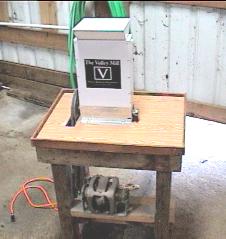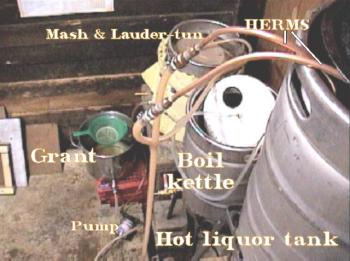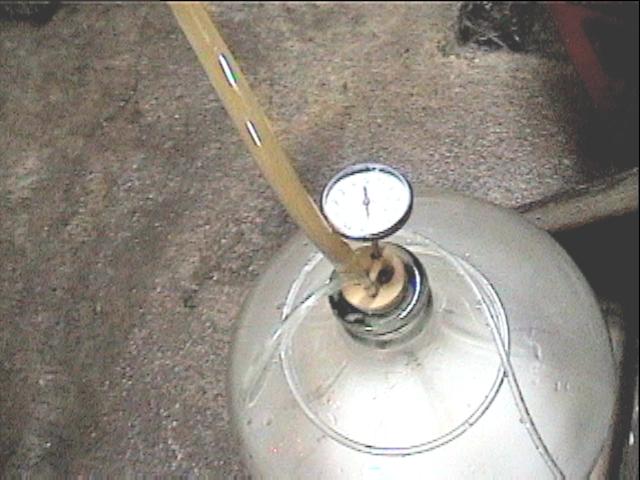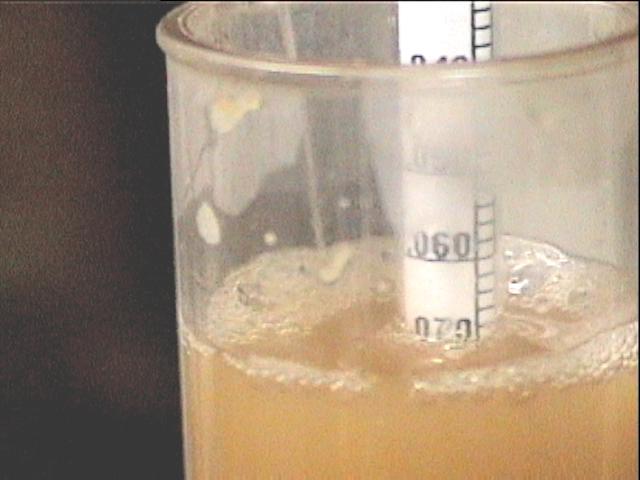
A place to brew, a place to play, a place to watch the hours slip away........Lets brew some Beer!
Of course all grain brewing takes time, about five hours for a five gallon batch and a bit more for 10 & 15 gallon brews, but it is a labor of love to create a craft homebrew!
We are brewing a ten gallon batch of I.P.A. (India Pale Ale) here. This is an all grain, single infusion mash held at 148 to 150 degrees for 70 minutes. I'll start by heating up 7 gallons of mash water to around 162 degrees for mash-in of the grain. The hot liquor, or sparge water kettle, will be filled up and heated as well. I have weighed my grain and am ready to crush it in the mill.

I use the Valley mill that is manufactured in Canada. I built a table for it and attached an electric motor to drive it. The mill will crush the grain into small pieces, separating the grain from the husk. Unlike milling flour, you don't want to turn your grain into powder as it would turn to mush and clog your false bottom or screen in your lauder tun. The barley husk also helps as a filter in the sparging process. Take a look at the projects page for more information on my grain mill.
After the mash water is heated, I'll stir in the crushed grain. The addition of this grain will cause a temperature drop to my target mash. I will hold this temperature of 148 degrees for 70 minutes. This is the sugar rest. It allows the grain to covert from starch to the fermentable sugars that we need. I use converted beer kegs for brewing. There are other types of kettles and containers that can be used in the process, some of which are pictured on the PROJECTS and BREWERY PHOTOS page.

It helps to insulate your mash kettle to keep the temperature constant while mashing or holding your grain as this conversion takes place. I put a foam cover around mine to help hold the heat. At the end of the mash you want to raise the temperature to 170 degrees for mash off. I use a homemade HERMS, (heat exchange recirculating mash system), to clear the wort, as well as raising the temp to 170 degrees, for sparging. The HERMS is made of 50 feet of 3/8 inch copper tubing, with fittings adapted to 3/8 hose barb. It sits in the hot liquor tank and I keep the water temperature at 180 to 185 degrees. As the wort is drawn from the lauder tun, it is pumped through the HERMS and back on top of the grain bed, raising the temperature to 170 degrees in about 20 to 25 minutes.
After recirculating and mash off temp is reached, I begin sparging into the grant or kettle, (shown below setting on the red milk box.) The idea of the sparging process, is to gently sprinkle 170 degree water on top of the grain bed, so that it flushes the sugars out of the grain. This sweet liquid is called wort, and will be boiled to make beer.
The keg that is used for this process contains a screen, just above the bottom of the pot, that has many small holes in it to hold the grain bed up and allow the sweet wort to be drawn through the valve at the bottom of the kettle. This vessel is called the Lauder-tun. It is the one with the white lid setting on top. This lid holds a rotating sparge arm to sprinkle the water evenly, over the grain bed. You can see the valve from the hot water tank at the lower right of this photo. The hot water tank contains the 170 degree sparge water and is called the hot liquor tank. I draw off the wort into the grant at a slow rate equal to how much hot sparge water is being added to the top of the lauder-tun. This process takes close to an hour for a five gallon batch. The grant is just a kettle with a valve on the bottom, that is hooked into the intake side of the pump. I collect a gallon or more of wort and then pump it into the boil kettle until I have the full volume for the boil. The output side of the pump is connected to the valve at the bottom of the boil kettle to fill from the bottom up, and minimize splashing.
After the full volume of wort is transferred to the boil kettle, the sparge will be stopped and the boil will begin. I add Hops in a nylon bag and tie them off to the top of the kettle. I do not have a screen that fits in any of my kettles for the boil process, so I use the nylon bags for now. For this batch of IPA, I have additions of hops for the full 60 minute boil, at the last 15 minutes of the boil, and some that are in the hop back as well.
After the boil, it is time to run the beer wort through the hop back, into the wort chiller and into the carboy. The idea of the hop back is to give the finished beer a nice aroma and fresh flavor. The short contact time of the hot beer wort with the hops makes this possible. The hop back also acts as a filter before running through the chiller.
From boil kettle to carboy, 210 degrees to 72 degrees in a matter of seconds. That is what the wort chiller does, it cools the beer. I am using a counter flow wort chiller. It consists of 3/8 inch copper coil that the hot beer wort runs through, and is surrounded by larger tubing that has cold water circulating around it. This rapid heat exchange chiller is very nice as the cooled beer wort becomes susceptible to contamination at temperatures below 170 degrees, and with my system it travels directly into the carboy with no contact to the outside air.

I'll pitch the yeast when I have the carboy about 1/4 full and then finish filling. When the carboy is full, I hook up an aquarium pump to aerate the wort, (the yeast needs oxygen), for around 25 minutes. I use the inlet hose to run off the resulting foam that is generated by aeration, and put a rubber plug on the 1/8" pressure relief tube, so that the foam will exit out the larger 3/8 plastic hose into a container.

With an original gravity of 1.070, It finished at 1.016 7% by volume!
Here are some explanation's of Beer terminology for those unfamiliar with the "lingo"
IPA or India Pale Ale: A very well hopped style of beer that originated with the British to preserve beer for the long ocean voyage to troops serving in India in the 1800's.
Wort: The term for beer before it is fermented into finished, drinkable form.
Husk: The outer part of a piece of grain that surround the kernel.
Sparge: To run hot water over and through the grain to extract the resulting sweet sugars.
Mash: The combination of barley grain in hot water at specific temperatures in order to convert the starch in grain to fermentable sugar.
Hot liquor tank: Another name for the hot water tank. No liquor in here, just hot water for sparging!
Lauder tun: this is the vessel that is used to extract the sweet beer wort from the grain while sparging. I use the same kettle for mashing and sparging when doing 10 & 15 gallon batches. (Mash-lauder tun)
Grant: Just another kettle. Used to monitor your rate of extraction during the sparge. When your not using a pump, a couple of plastic buckets work fine. Just draw off around a gallon, switch buckets & dump into your boil kettle.
HERMS: as explained above, it is a heat exchange system to increase the temperature of your mash.
Wort chiller: You need to cool the beer wort as fast as possible to avoid any contamination and to add the yeast.
Pitch the yeast: Adding the yeast to the beer.
Yeast: A living organism. It eats sugar and converts it to alcohol. It also gives beer unique flavors.
Original gravity: The
way you determine the alcohol content of your beer is to weigh the sugar content
of the beer before and after fermentation. The beer will be heavier
because of the large sugar content at first. This is called original
gravity. When the yeast eats the sugar and converts it to alcohol,
it becomes a lighter liquid. When finished fermenting, this is known as
the Finished gravity. The reading of the finished beer is subtracted from
the "original gravity" reading, and multiplied by a formula to
determine the alcohol content. This is done with the Hydrometer,
pictured above.
This rubber plug on the carboy has four holes. the inlet for the cooled wort, a tight fitting hole for my thermometer, the tubing for the aerating process and a 1/8" piece of copper tube for pressure relief as your filling the carboy. I can monitor the temperature of the wort and adjust the water flow in my wort chiller to maintain the desired temperature that I want the beer to be for the addition of yeast.
Hop Growing at Deer Island
/
Projects / News & Events
Favorite Brew Pubs
/ More Great Beer Sites
![]()